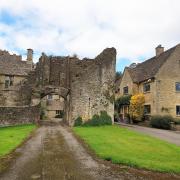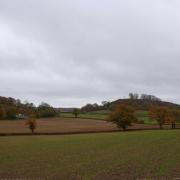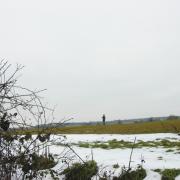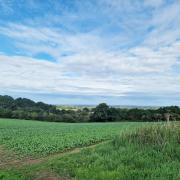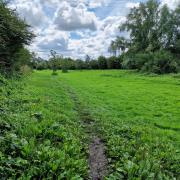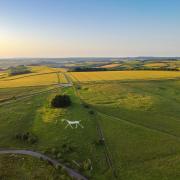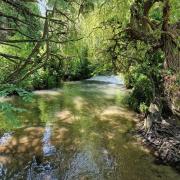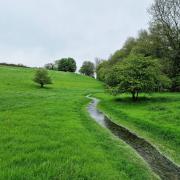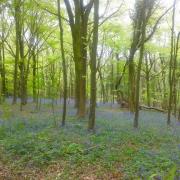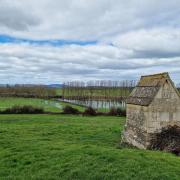Tales of risen corpses, Devil worship, bewitchment, and murder on a stroll round a lovely Warwickshire village

Sometimes a place acquires a particular kind of associations in the realm of lore and legend. In the case of Long Compton, it’s witchcraft. Or perhaps we should say ‘witchcraft and necromancy’, for the most substantial tale from this village concerns the raising of the dead.
If you’d like to take a walk through the creepy folklore and beguiling scenery of Long Compton, you can find a spot to park on Back Lane, parallel to the main road. It’s a short walk up the lane to Langley Cottage, where a left turn along Broad Street takes you to the main road. Turn right here, past an old well, and you’ll see the half-timbered lychgate into the churchyard of St Peter & St Paul’s. The present church dates from the 13th century. In its porch lies the effigy of a woman, whom some say was a witch, because of her malevolent stare and the creature on which she rests her feet. The stonework is now so worn you can’t make out much of either. Indeed some have even imagined the figure to represent St Augustine.

It’s said that in AD 604 Augustine, the first archbishop of Canterbury, paid a visit to the earlier church on this spot. He was unimpressed when the parish priest told him the Saxon lord of the manor was refusing to pay his tithes to the church. These were early days for the Church in England, so Augustine had to be assertive. When the lord remained obdurate, Augustine excommunicated him and commanded, ‘No excommunicated person may be present at Mass!’
But it wasn’t just the lord of the manor who had to step outside. At the Archbishop’s words, slabs of stone in the church floor jerked upright and a skeletal corpse erupted from the earth and lurched to the door to wait outside with the lord.
Upon questioning, the corpse told Augustine he’d been a patron of the church 150 years before, in Romano-British times, and was excommunicated by the priest of that time because he hadn’t paid his tithes. ‘Ever since I died I’ve suffered the torments of hell.’

After more detective work, Augustine located the grave of the British priest who’d excommunicated the dead man. He lifted his crozier and summoned this priest from his eternal rest. More flagstones burst up and another corpse clambered out. In a creaking whisper he confirmed what had happened: ‘He was a sinner and so I cast him out of Christ’s flock.’
‘Why then was he buried in the church?’ asked Augustine.
‘Don’t ask me,’ quavered the skeletal priest. ‘I was dead by then.’
As the excommunicated corpse was showing some regret at how life, or rather death, had panned out, Augustine took pity. He gave him a scourge so he could whip himself now and again to deal with any guilty feelings, and asked the dead priest to absolve him of his sins. Then the corpse staggered back into his grave and crumbled into dust.
The Archbishop turned to the zombie priest: ‘As recompense for your services today, you may resume your life on earth.’
The corpse looked at the ashen-faced congregation and the evidence among them of illness, injustice, and warcraft. ‘If you don’t mind, I was happy enough enjoying the delights of heaven.’ So saying, he returned to his grave, where he too crumbled into dust.
After all this, the lord of the manor was quick to pay his dues, the parish priest welcomed him back into the fold, and Augustine rode on to the next parish and whatever else needed sorting out.

All that remains of the lord’s manor house are some earthworks in the adjacent field. You can get there by turning right from the churchyard, taking the first entry on the right, and following the short track to a stile into the field. Here a man once sold his soul to the Devil. He drew a large circle in the field, recited the Lord’s Prayer backwards, and the Devil flamed forth, escorted by 12 hairy imps.
Cross this field to the gate, turn right along the lane, past some cottages, then go left on the main road a few yards before bearing right into the lane up Harrow Hill. Take care if you do this walk in winter. At dusk in that season, especially after a storm, a phantom coach and four comes down here at full tilt. Don’t expect it to stop. Both the driver and all four horses are headless.

After a quarter of a mile, take the path on the right through an arable field. Now you’re well out of the village, you can relax a bit. The only things that might spook you are a witch in the form of a white rabbit – and another witch shapeshifted into a white hare with a penchant for running in circles to scare the normal rabbits.
From the field’s far corner, proceed up the edge of the next field to the road. The footpath continues into a wood on the opposite side and veers north to give you a brief view of the Stour valley. At the junction of paths, turn right, back to the road, where you turn left, and then through a metal gate on the right into Whichford Wood. Here you’ll see lots of bluebells in spring. Turn left on the Macmillan Way, which runs along the southern edge of the wood. When you reach a stand of exotic pines, look for a path on the right which leads diagonally across an arable field, through another arm of woodland, and then down a beautiful long meadow. Cross the track at the bottom and walk through another field to return to the top of Back Lane.

Many other witchy activities are recorded in Long Compton. One witch was said to ride along the road in a dough kibbler (a machine for cutting up dough). A certain old lady was unable to die while her friends and family were present; when they stepped out of the room they heard a lively commotion, and when they opened the door again the room was in disarray and they glimpsed a black pigeon flutter from the window. A hedge healer called Will Walker treated animals with diverse herbal remedies – including deadly nightshade, which helped to allay swine fever. And there’s the famous witch who brought into being the Rollright Stones a mile south of the village.
Folklore can be fun even when it’s grim and ghoulish. It can also be intriguing. It sometimes makes you wonder what to believe. But it’s clear that folklore has a dangerous side when you consider beliefs about witchcraft. In 1875 an 80-year-old woman, Ann Turner, was viciously murdered in Long Compton by her neighbour John Haywood, who blamed on her evil eye his aches and pains and all manner of misfortune in the village. He was befuddled by cider and had been convinced by a ‘water doctor’ that if he turned a bottle of his own urine upside down and bubbles rose to the top then it proved he was bewitched. The law took a dim view of Heywood’s beliefs and he’d have been hanged if he hadn’t been incarcerated as insane. But it’s a stark reminder not to give too much credence to everything you hear, and that what matters even more than what you believe is the kindness of your words and actions.

ESSENTIALS
Distance: 4 miles / 6.4 km.
Duration: Two hours.
Level: Easy.
Parking: Road parking on Back Lane.
Toilets and refreshments: The Red Lion, Long Compton.
Transport links: Shipston Link runs bus services connecting Long Compton with Shipston-on-Stour, Chipping Norton, and Banbury. Stagecoach’s No. 50 runs between Chipping Norton and Stratford-upon-Avon.
Map: OS Landranger 151 Stratford-upon-Avon.
LINKS
Route: https://gb.mapometer.com/walking/route_5242139.html
Long Compton: discovercotswolds.co.uk/long-compton/
Kirsty Hartsiotis and Anthony Nanson are Stroud-based storytellers and writers. Their books include Gloucestershire Folk Tales, Wiltshire Folk Tales, Gloucestershire Ghost Tales, and Gloucestershire Folk Tales for Children. Kirsty is also the curator of decorative and fine art at The Wilson Art Gallery and Museum, Cheltenham. Anthony runs the small press Awen Publications






